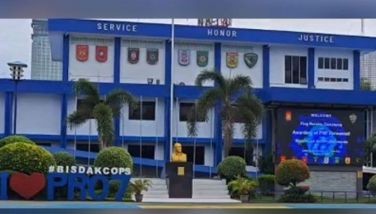All city rivers filthy
CEBU, Philippines — Cebu City is not environmentally-attuned and compromised water quality for rapid urbanization, the Cebu City Environment and Natural Resources Office (CCENRO) said in a report to the City Council.
The report, dated July 16, 2024 and prepared by Engr. Myka Marie Llanos, CCENRO, was endorsed to the City Council by CCENRO Officer-in-charge Reymarr Hijara during the City Council session last Aug. 7.
One alarming portion of the report is that analysis of the water quality results showed that there is a high fecal coliform content in all the (seven) rivers , especially at the downstream portion.
CCENRO said the count has reached 13,000,000 MPN/100 mL, which is so far beyond the limit of 400 MPN/100 mL, or 3,249,900 percent more than what is safe.
A huge portion of contributors of the high fecal coliform content in the rivers would be the settlers along the three-meter easement, CCENRO said.
It mentioned that it was learned during a recent field survey that a huge percentage of these settlers directly release human wastes into the rivers. as they do not have septic tanks or any form of septage treatment.
The City Government, though, is currently in the middle of a campaign to really remove structures within the three-meter easement of all its rivers.
The submission of the CCENRO report was prompted by the approved resolution of City Councilor Jose Lorenzo Abellanosa, who requested the Department of General Services and CCENRO, in coordination with the Department of Engineering and Public Works, to urgently monitor and identify the rivers within the jurisdiction of the City of Cebu .
Abellanosa s purpose was to identify which of the city s seven rivers may require immediate clean-up and desilting, so appropriate measures could be taken.
As of 2022, there are no remaining rivers in Cebu City that pass the highest standard of water quality which is Class AA or Class A, stated the CCENRO report.
Class AA or Public Water Supply Class 1, are intended primarily for waters in watersheds, which should be uninhabited or otherwise declared as protected areas.
These kinds of water sources only require approved disinfection to meet the latest Philippine National Standard for Drinking Water, CCENRO said.
The Class A of the Public Water Supply Class II, on the other hand, are the water resources intended as sources of water supply requiring conventional treatment (coagulation, sedimentation, filtration, and disinfection) to meet the latest Philippine National Standard for Drinking Water .
CCENRO said Cebu City s rivers do not meet this level of quality despite the fact that a huge portion of Cebu City is declared as a Central Cebu Protected Landscape.
This could be an indication that although the City of Cebu is a highly developing city with rapid urbanization, the city however, is not environmentally-attuned, compromising our water quality that would consequently threaten our water supply, as well as the city's ecological health and balance, it said.
Cebu City s rivers are the Bulacao River, Kinalumsan River, Guadalupe River, Estero de Parian, Lahug River, Mahiga River, and Butuanon River.
Three of these intersect with neighboring cities, namely: the Bulacao River in the south, which is shared with Talisay City, and the Mahiga and Butuanon rivers, which are shared with Mandaue City.
The CCENRO s report also cited the respective classifications of each river. The Guadalupe River is classified as Class C in the downstream portion and Class B in the upstream portion.
CCENRO said in its report that Class B waters, or the Recreational Water Class I, are intended for primary contact recreation such as bathing, swimming, and skin diving, among others , while Class C, are fishery water for the propagation and growth of fish and other aquatic resources .
Class C waters also caters to recreational water such as boating, fishing, and similar activities. Class C waters can also be used for agriculture, irrigation, and livestock water .
Meanwhile, the entire length of the Butuanon River is classified as Class D, or navigable waters , which means that it can be traversed over with a boat to deliver materials or people .
The Kinalumsan River, on the other hand, is classified as Class B, upstream; Class C, midstream; and Class D, downstream; while the Mahiga River is Class D, downstream and Class C, upstream.
Lahug River, on the other hand, is classified as Class D all throughout, while Bulacao River is classified as Class D, downstream; and Class C, upstream.
Furthermore, CCENRO said that although Estero de Parian is the shortest among the seven rivers, covering only three barangays, it failed in all water testing parameters except for total suspended solids , which is why it got no classification.
CCENRO stated in the same report that it is doing regular quarterly clean-ups of the coastal areas, rivers, and natural waterways through the Coastal Management Task Force.
To quantitatively measure and assess the efficacy of the City Government's concerted effort to clear and clean the rivers and waterways of Cebu City, a water quality monitoring must be conducted. The results of the water quality assessment will serve as a lag measure on whether the activities conducted by the City are effective in the rehabilitation of the water bodies, it said.
CCENRO also told the City Council that the city will have its own water quality assessment capability and need not depend anymore on the Department of Environment and Natural Resources as to when and where water testing will be done among the city's rivers. (CEBU NEWS)
- Latest

























